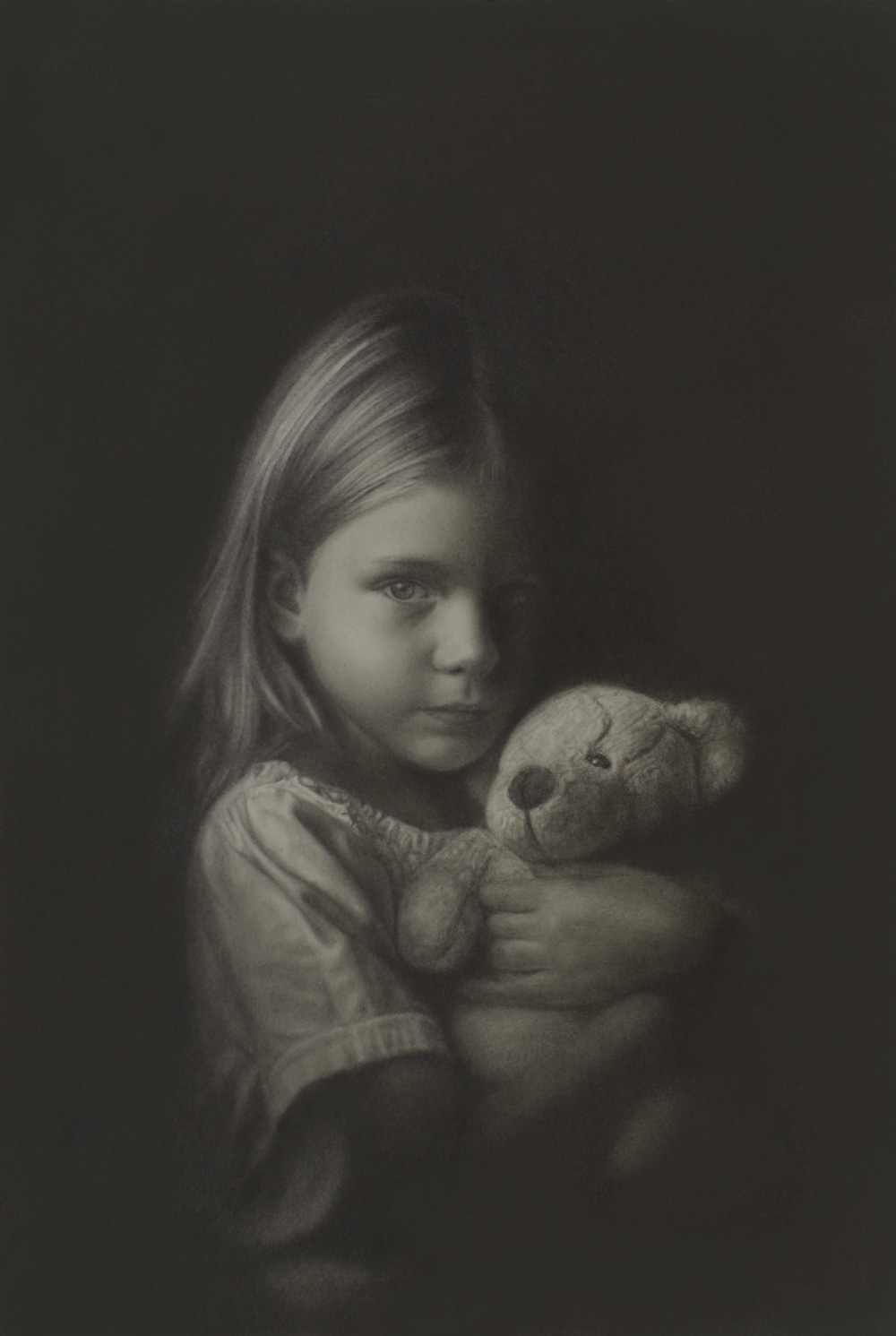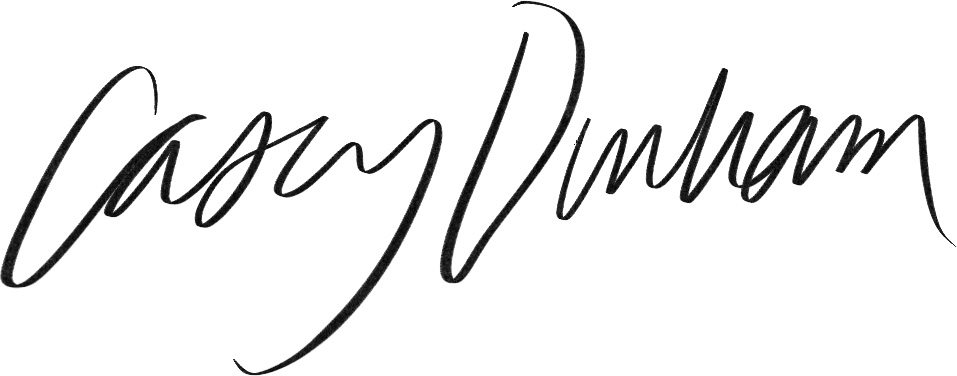

Treasured

Height: 18" x Width: 14" | Material(s): Graphite, charcoal, drawing paper | Process(es): Used blending tools to create a soft effect and charcoal to bring out the dark values | Idea(s): How can art explore solitude and stimulate viewer reflection through realistic portraiture? | Curatorial Note: The use of tenebrism to illuminate the young girl and her stuffed animal in the darkness expresses a sense of loneliness effectively.
Casey Dunham
Student statement
Student statement
Does your work reference or draw on a contemporary or historical art-making style, practice, or tradition? If so, please explain.
No, it does not reference a specific style, practice, or tradition. The vision behind this artwork exists in the composition and graphite work. I hoped to convey a sense of loneliness and isolation through this manner.
Describe how your inquiry evolved as your sustained investigation developed.
My inquiry evolved throughout the process of creating my portfolio. Originally planning on focusing solely on graphite portraiture, I decided to add a final piece in color showing two brothers in order to emphasize the contrast between isolation and togetherness. I created this piece using cutouts from magazines and glueing them together to create a vivid image. The reference photo I used was of my brothers reading together on a couch. This was a creative choice that tied my portfolio together.
How did this artwork relate to your sustained investigation inquiry?
My inquiry explored the depiction of loneliness and solitude through realistic portraiture. Contemporaneous art tends to express emotion through surreal depictions, yet I wanted to explore solitude and isolation through more traditional, classic-style art. In this drawing, I attempted to convey a sense of isolation and innocence through composition and dramatic lighting. The girl is carved out with light from a dark background. She is exposed from her hiding, drawn out from the shadows into the soft, cold light.
With this query, I aimed to capture the essence of solitude.
How did you practice or improve your written inquiry statement as your portfolio developed?
When composing the written statements, I made sure to be concise, thorough, and honest. With the small word limit, my ability to explain my pieces was limited. I experimented with different ways to get my ideas across and had my peers read the responses to get feedback.
How did your art teacher support your artistic development?
I am incredibly thankful for my art teacher's support towards my artistic development. Throughout my creative process, my teacher offered salient advice to help me better achieve my goals. When I was stuck thinking linearly, she helped to expand my thinking. She introduced new ideas and techniques that helped bring my vision to life and encouraged my creativity. Under her tutelage, I grew not only as an artist, but as a person. I'm incredibly grateful for her willingness to pour into her students.
What is your advice to other AP Art and Design students?
My advice to other AP Art and Design students is to do what you love. Explore a topic you're interested in and think out of the box to find new ways to express that interest. More than ever, our world is in need of creativity. You are the one capable of achieving that. As artists, our goal is to bring something alive off the page—to take inanimate brushstrokes and turn them into breathing, dancing entities. This is no small responsibility. Now is your time to introduce new ideas into the world and impact others through meaningful work. Art offers a soulful connection that can only be attained through creative means. Your job is to be the medium through which yourself and the viewer can connect to something beyond the physical, to access an almost spiritual connection to the soul. There is no wrong way to do this—art is simply expression on a page. Let your heart flow through your hand.

Emily Costa
Secondary Visual Arts Teacher
Wilmington Christian School, Hockessin, DE, USA
Teacher statement
Teacher statement
The AP Art and Design course supports inquiry-based personalized learning in the sustained investigation portfolio component.
What strategies helped you guide students through inquiry?
Encouraging students to have a personal connection to their work helps them to ask important questions about what they are communicating through their visual artwork and how best to accomplish this communication. With a student like Casey, to whom realism is very important, we talked about formal choices that set a certain mood, such as the darkness of a background making a figure feel isolated or lonely.
How did you scaffold writing into the art-making and thinking processes?
Students begin the year in AP Drawing studio with a written reflection that guides them through a thoughtful recap of the last year or two of their most successful art pieces. It starts them off writing, and as they work on new ideas, they do short bursts of journaling that help themto flesh out their ideas and thought processes in words as well as sketches.
How did you support skill development AND inquiry in the AP Art and Design curriculum?
The prerequisite to AP Drawing is Honors Art, which develops skills through rigorous drawing assignments, as well as projects based on art historical movements. Through the process of developing ideas in AP Drawing class, students do a lot of sketching to develop their compositions. Casey would sketch ideas to work out a composition and then create a photographic reference to her own specifications with help from models and props.
How did you structure practice, experimentation, and revision into your AP Art and Design curriculum?
A student like Casey is always practicing and revising, and is her own harshest critic. So in her case, my job is very easy. She works from home frequently, bringing her work back and forth from home to the classroom, and produced plenty of work at the highest level of quality. She did enjoy experimenting with other media like acrylic paint, collage, and Procreate, but she always returned to the finely rendered details of graphite and charcoal, working from high-quality photos that she would take herself.
How do you support your students in the Selected Works portfolio component?
Students are always surprised to learn that the selected works do not have to reflect their inquiry, although often they will still choose works that do. But I encourage them to assess their drawing skills and choose works that reflect their skills most accurately. Casey consistently produced excellent examples of drawing skills, surpassing expectations.
What formative and summative assessments helped guide your students through your AP Art and Design curriculum?
There are checkpoints at the middle and end of each quarter where I assess the quality of the work that has been done, as well at the artistic habits of the individual students. We do group critiques that showcase the work of the first semester as a class, where they are given feedback on their body of work as a whole. This helps to point them into the second semester with a clear idea of their continued inquiry.
What creative programming (i.e., exhibit spaces, mentoring programs, curricular supports) have you implemented to support AP Art and Design students?
We have a large gallery area where the students will put on their own AP show, displaying their work from the year as a cohesive, whole portfolio. We also go to museums and/or galleries to see contemporary work. Whenever possible, we will bring in visiting artists and encourage art students to enter competitions that will bring them more exposure and experience with adjudication.
What did you learn from working with your student?
Most students do not display the work ethic, attention to detail, and drive to improve that Casey displays. I love seeing that this kind of curiosity and insistence on quality is still alive. I have learned to give my own artwork more time, and I have regained an interest in realism that I had let go of for a time.
Is there anything your school leadership does to support your art students or the art program?
Our school leadership is very supportive, and makes sure to give gallery space to our student artists. They do their best to financially get behind the needs that come up from year to year.
What is your advice to other AP Art and Design teachers?
There are students out there that will renew your love of teaching and your appreciation for art, not every year, perhaps, but they are out there. Make your classroom a space of safety and community that also upholds high standards.

Casey Dunham







